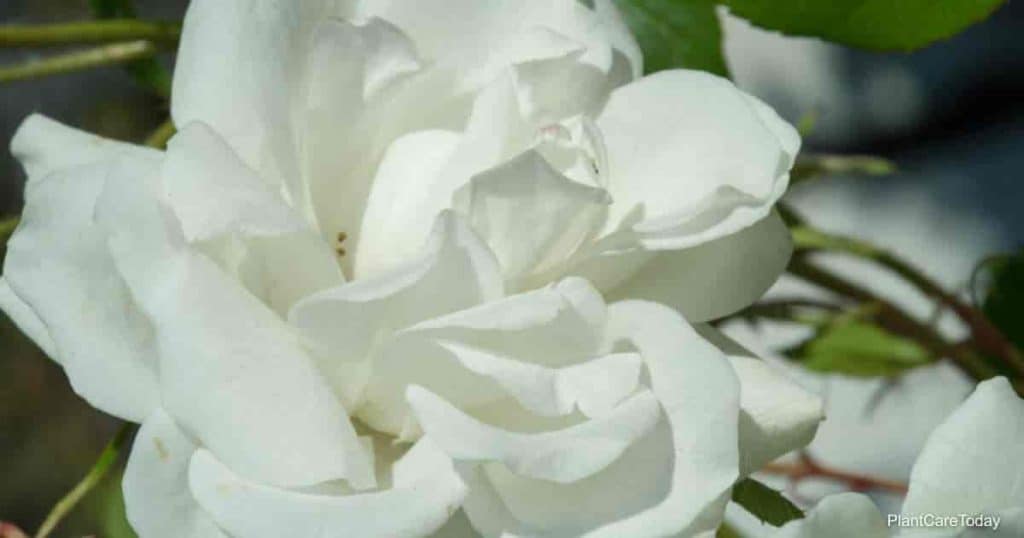Gardenias are an amazing addition to most gardens, growing in USDA hardiness zones 6 to 11.
The Gardenia genus contains more than 140 species and is part of the Rubiaceae family (the same family as coffee).

Most of the varieties are cultivars of Cape Jasmine, AKA common gardenia (Gardenia jasminoides). There are dwarf varieties that can grow indoors reaching a maximum height of 18” inches.
But, gardenia’s claim to fame comes from the Gardenia flower. The blooms often resemble roses in shape and give off an intoxicating scent.
Coming from Africa, Southern Asia, and northern Australia, these tropical beauties can require a little more care. But the results are well worth the effort.
Unfortunately, gardenia isn’t immune to pests, like scale insects and aphids.
It’s essential to get rid of aphids immediately to keep your plant alive, healthy, and blooming.
What Are Aphids?
The aphid is part of the Aphidoidea superfamily and includes a wide range of shapes and sizes.
Most aphids tend to be wingless with soft bodies. The females give live birth to nymphs and they multiply rapidly.
Because they tend to be under ¼” inches long, aphids can be very difficult to spot. Many common aphid species are green, and sitting on top of green leaves gives them a disguise.
What Damage Do Aphids Cause To Gardenias?
The design of aphid mouthparts allows them to pierce a gardenia plant and suck the plant juices out of the veins.
Plant sap acts as the blood of plant life. Losing too much has the same consequences as humans losing too much of their red equivalent.
The plant’s immune system will collapse, resulting in many symptoms.
Yellow leaves on gardenias are often associated with other health issues and are one of the first signs of aphid infestation.
You might find galls (abnormal swollen growths along the stem). These result from lesions caused by pests, much as your skin may swell around a bug bite.
Aphid waste, a sticky substance known as honeydew, attracts other pests, especially ants.
This honeydew can also lead to sooty mold fungus if left on the plant. Making it more difficult for the Gardenia to get enough light.
Other insect pests attacking Gardenia include Spider Mites | Gardenia Whitefly | Scale Insects | Thrips
For more read: Common Gardenia Pests and Diseases?
How To Control Aphid Gardenia Pests
There are a wide variety of chemical options available. Many harm beneficial insects and pollinators as well as Gardenia pests.
There are several safe and effective options to combat aphid infestations using chemicals or home remedies.
Chemical Controls
The two best chemical options to control aphids are products containing pymetrozine and pyriproxyfen.
Pymetrozine disrupts the pest’s feeding habits when sprayed onto the plant.
Pyriproxyfen interrupts nymphs’ molting process, so they can not become adults and reproduce.
The full effects of these two chemicals on pollinators are unknown. Pyriproxyfen is mildly toxic to bees.
For safety, spray your gardenias early in the morning or late at night, and avoid spraying near beehives.
Related: Gardenia Bugs
Natural Alternatives
There are quite a few recipes out there that kill Gardenia aphid populations. A lot of them involve the use of spray bottles.
A few of these recipes include:
Recipe #1
- Plain water (will knock the insect pests off so you can squish them)
Recipe #2 (Insectidical Soap)
- 1 – quart water
- One tablespoon Dawn dish soap (the soap clogs an aphid’s airways)
- Add several drops of eucalyptus oil
DO NOT apply insecticidal soaps or horticultural oils when temperatures are above 90° degrees Fahrenheit. Prevent foliar injury by applying sprays late in the day. [source]
Recipe #3
- 1- gallon of water
- A dash of cayenne pepper
- Two teaspoons of 35% percent hydrogen peroxide
Be sure to spray the mixtures on all surfaces of the plant every 2 to 3 days for two weeks. This kills not only the aphids but any hatching aphid eggs.

Oil sprays like Neem oil and horticultural oil are other great remedies. Wipe or spray the mixture onto all surfaces and crevasses of the plant. Follow the label directions for mixing.
Alternatively, you can wipe the plant down with 1% percent hydrogen peroxide.
Finally, plant complimentary items, such as:
- Garlic
- Onion
- Catnip
- Marigolds
… close by to repel aphids and attract beneficial insects like green lacewings, parasitic wasps, lady beetles, and butterflies.